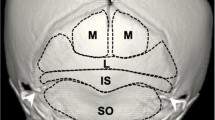Abstract
Purpose
Radiologic diagnosis of skull fractures in young children is difficult due to numerous accessory sutures. This is especially true around the occipital bone because it has more than one ossification center. Normal anatomic variants, such as the mendosal suture, may be misinterpreted as a skull fracture. We investigated the anatomic traits of the mendosal suture in young children.
Methods
We retrospectively evaluated 52 children, aged between 1 month and 4 years, who had undergone head computed tomography with three-dimensional reconstructions. We evaluated the presence or absence of the mendosal suture. If present, then we measured the length of the suture and the angle between the lambdoidal and mendosal suture lines.
Results
The presence of the mendosal suture was bilateral in 12 children and unilateral in 5 children. The mendosal suture had a mean length of 13.9 ± 3.4 mm on the right side and 11.2 ± 4 mm on the left side. The angle between the mendosal and lambdoidal sutures had a mean value of 54.2° ± 11° for the right side and 53.6° ± 13.9° for the left side. The 95 % confidence interval for the mean value of the angle had a lower and upper bounds of 48° and 60° on the right side and 46° and 61° on the left side, respectively.
Conclusions
The angle between mendosal and lambdoidal suture lines may help radiologists to identify the mendosal suture.



Similar content being viewed by others
References
Allen WE 3rd, Kier EL, Rothman SL (1973) Pitfalls in the evaluation of skull trauma. Radiol Clin North Am 11:479–503
Anton SC (1997) Developmental age and taxonomic affinity of the Mojokerto child, Java, Indonesia. Am J Phys Antropol 102:497–514
Borg J, Holm L, Cassidy JD, Peloso PM, Carroll LJ, von Holst H, Ericson K (2004) Diagnostic procedures in mild traumatic brain injury: results of the WHO collaborating center task force on mild traumatic brain injury. J Rehabil Med 43(Suppl):61–75
Chasler CN (1967) The newborn skull. The diagnosis of fracture. Am J Roentgenol Radium Nucl Med 100:92–99
Choudhary AK, Jha B, Boal DK, Dias M (2010) Occipital sutures and its variations: the value of 3D-CT and how to differentiate it from fractures using 3D-CT? Surg Rad Anat 32:807–816
Ditty BJ, Shoja MM, Tubbs RS, Loukas M (2012) The mendosal suture. Clin Anat 25:521–523
Franken EA (1969) The midline occipital fissure. Diagnosis of fracture versus anatomic variants. Radiology 93:1043–1046
Gayretli O, Gurses IA, Kale A, Aksu F, Ozturk A, Bayraktar B, Sahinoglu K (2011) The mendosal suture. Br J Neorusurg 25:730–733
Gooding CA (1971) Cranial sutures and fontanelles. In: Newton TH, Potts DG (eds) Radiology of the skull and brain, vol I/Book 1. The C. V. Mosby Company, St Louis, pp 216–237
Hanihara T, Ishida H (2001) Frequency of discrete cranial traits in major human populations. II. Hypostotic variations. J Anat 198:707–725
Lloyd DA, Carty H, Patterson M, Butcher CK, Roe D (1997) Predictive value of skull radiography for intracranial injury in children with blunt head injury. Lancet 349:821–824
Lochmuller CM, Marks MK, Mileusnic-Polchan D, Cogswell SC (2011) Misidentification of a transverse occipital suture as a persistent mendosal suture. J Pediatr 159:876–877
Madeline LE, Elster AD (1995) Suture closure in human chondrocranium: CT assessment. Radiology 196:747–756
Mann KS, Chan KH, Yue CP (1986) Skull fractures in children: their assessment in relation to developmental skull changes and acute intracranial hematomas. Child’s Nerv Syst 5:258–261
Matsumura G, Uchiumi T, Kida K, Ichikawa R, Kodama G (1993) Developmental studies on the interparietal part of the human occipital squama. J Anat 182:197–204
Miller AJ, Kim U, Carrasco E (2010) Differentiating a mendosal suture from a skull fracture. J Pediatr 157:691
Mulliken JB, Le MN (2008) A craniofacial glossary. J Craniofac Surg 19:705–712
Mulroy MH, Loyd AM, Frush DP, Verla TG, Myers BS, Bass CR (2012) Evaluation of pediatric skull fracture imaging techniques. Forensic Sci Int 214:167–172
Nakahara K, Miyasaka Y, Takagi H, Kan S, Fujii K (2003) Unusual accessory cranial sutures in pediatric head trauma. Neurol Med Chir (Tokyo) 43:80–81
Nakahara K, Utsuki S, Shimizu S, Iida H, Miyasaka Y, Takagi H, Oka H, Fujii K (2006) Age dependence of fusion of primary occipital sutures: a radiographic study. Child’s Nerv Syst 22:1457–1459
Nayak SR, Krishnamurthy A, Madhan Kumar SJ, Prabhu LV, Jiji PJ, Pai MM, Kumar A, Avadhani R (2007) The mendosal suture of the occipital bone: occurrence in Indian population, embryology and clinical significance. Surg Rad Anat 29:329–332
Pinto PS, Poretti A, Meoded A, Tekes A, Huisman TAGM (2012) The unique features of traumatic brain injury in children. Review of the characteristics of the pediatric skull and brain, mechanisms of trauma, patterns of injury, complications and their imaging findings-Part 1. J Neuroimaging 22:e1–e17
Tubbs RS, Salter EG, Oakes WJ (2007) Does the mendosal suture exist in the adult? Clin Anat 20:124–125
Shapiro R, Robinson F (1976) Embryogenesis of the human occipital bone. Am J Roentgenol 126:1063–1068
Srivastava HC (1992) Ossification of the membranous portion of the squamous part of the occipital bone in man. J Anat 180:219–224
Webber RL, Folio J (1976) Radiographic detectability of occipital and temporal-parietal fractures induced in cadaver heads. J Trauma 16:115–124
Acknowledgments
We wish to express our gratitude to Emrah Can M.D. for his valuable contribution and guidance with the statistical analysis and David F. Chapman BSc. for editing the English of the final version of the manuscript.
Author information
Authors and Affiliations
Corresponding author
Ethics declarations
Conflict of interest
The authors declare that they have no conflict of interests.
Rights and permissions
About this article
Cite this article
Gurses, I.A., Esenkaya, A., Gayretli, O. et al. A new anatomic trait for identifying the mendosal suture in young children: the mendosal–lambdoidal angle. Surg Radiol Anat 38, 321–325 (2016). https://doi.org/10.1007/s00276-015-1556-y
Received:
Accepted:
Published:
Issue Date:
DOI: https://doi.org/10.1007/s00276-015-1556-y




